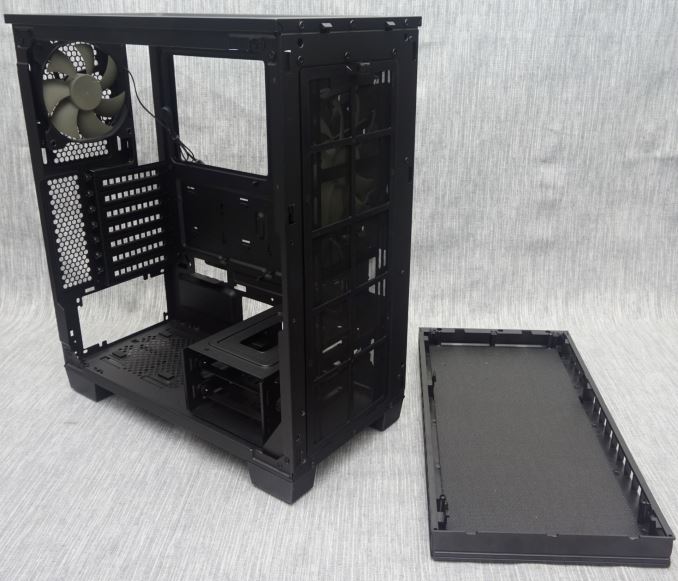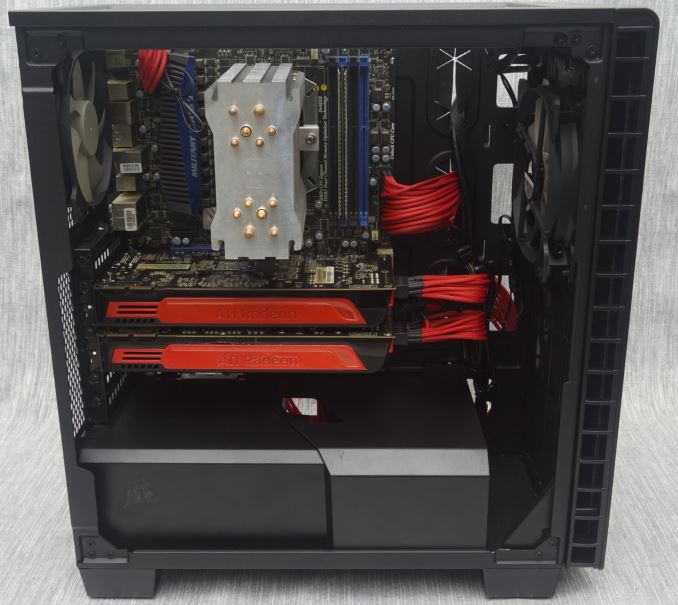The Corsair Carbide 400Q Case Review
by E. Fylladitakis on April 29, 2016 9:00 AM EST- Posted in
- Cases/Cooling/PSUs
- Corsair
- ATX
- E-ATX
- Carbide
Conclusion
With the Carbide 400Q, Corsair wanted to create a compact and elegant case that also offers good thermal performance and very low noise levels, all for a reasonable price tag. These are just too many eggs for one basket and a single design cannot possibly excel on all five of those areas. It is the balance between them that matters and we feel that Corsair did a fine job balancing their design to the best possible extent.
The Carbide 400Q is one of the most compact cases currently available that can support an Extended ATX motherboard, as well as top tier graphics cards and liquid cooling systems. It cannot support many drives but these are more than enough for the majority of home and office users, most of which own a maximum of two or three drives. There is no support for external drives, forcing users who want to work with optical media to go for an external device. This can be a problem for professionals, especially for those that need to receive or share digital material with their customers. Most home users and gamers will not mind, as the bulk of digital material is being transferred online nowadays.
In terms of quality, the Carbide 400Q is very good overall. The mechanical strength of the steel chassis is excellent. It is next to impossible to bent or twist the chassis, even if a lot of force is applied. The paint job is excellent, highly resistant to fingerprints and scratching. Our only concern lies with the plastic frame of the faceplate. The plastics are thick and of very good quality, but it is very tightly attached to the metallic frame of the case, requiring a lot of force to remove it.
With the stock configuration in mind, the balance between thermal performance and acoustics is towards the latter, but the Carbide 400Q still offers thermal performance comparable to that of most ATX tower cases and can easily support a relatively powerful system. If the user wants to, the Carbide 400Q can support even systems with triple graphics cards and liquid cooling, but that would require the removal of the top panel cover and the installation of more and more powerful fans. This would defeat the purpose of buying the Carbide 400Q in the first place, as the end result would probably be a cramped, noisy setup.
In conclusion, the Carbide 400Q is finely balanced between thermal performance, size and acoustics. It currently retails at it MSRP price of $99, which is reasonable for such a case but, in our opinion, if it could have been a little lower it would be more competitive in a crowded market. Nevertheless, the Carbide 400Q can be a very good choice for a typical gaming PC, allowing for relatively low noise levels and good thermal performance using the stock configuration with the case fan thermally controlled by the motherboard.












63 Comments
View All Comments
mostlyharmless - Saturday, April 30, 2016 - link
I've never seen a case with a modular (on/off, mike/headphone, USB) section that could be relocated to various areas of the case (top, upper front, lower front). Though it'll be a non-issue when all ports are wireless.Murloc - Sunday, May 1, 2016 - link
meh it would look ugly, plus there are so many cases that all use cases are covered.mostlyharmless - Sunday, May 1, 2016 - link
... until you moved your PC to a new location & something different would be more convenient.egmccann - Wednesday, May 4, 2016 - link
True. It was one of the irritations I had with my old Sonata (and my current coolermaster case, actually.)As far as this case... no external drive access means it's not for me. Which is to bad, as I kind of like the straightforward aesthetic. (I don't want or need case windows, lights, etc.)
Valantar - Monday, May 2, 2016 - link
Considering the amount of wiring coming out of front I/O panel, they aren't exactly easy to move around. It would probably be doable, but I'd bet not worth ruining the aesthetic of the case for 99% of designers.tromedo - Monday, May 2, 2016 - link
Any idea when motherboards will have internal USB Type-C Headers and the case manufacturers will adopt it for the front panel?colonelclaw - Tuesday, May 3, 2016 - link
I was wondering that myself. Should we be expecting a $99 case to have USB-C or is it too soon to be thinking that way?Haravikk - Monday, May 2, 2016 - link
Looks like a good case; I'm very much a fan of the muted looks and the sensible internal layout. Bit disappointed that the sides require thumbscrews and the front is friction fit when the top is magnetic, as I wouldn't mind paying a bit extra for some decent strength magnets for super-easy access.I know it's pretty typical to only review the bundled fans, but it would have been nice to see what kind of differences could be expected with different fan arrangements. I'm particularly interested in what the case might be like with liquid cooled graphics and the biggest passive CPU cooler that money can buy, leaving the top open. At modest fan speeds I imagine it should still be pretty quiet for modest gaming demands (not high end pushing it to the limit sort of stuff, which has never really interested me anyway, I prefer quiet).
pikunsia - Monday, May 2, 2016 - link
Since I can't put my ASUS DVD-RW and my PIONEER BD-RE, this case is not for me. My Corsair 450D is eminently superior to this case.AnnonymousCoward - Thursday, May 5, 2016 - link
It looks like Corsair copied the Fractal Design R5, but insanely dropped support for optical drives (in a desktop tower!), and supports only a 120mm rear fan instead of all 140mm.